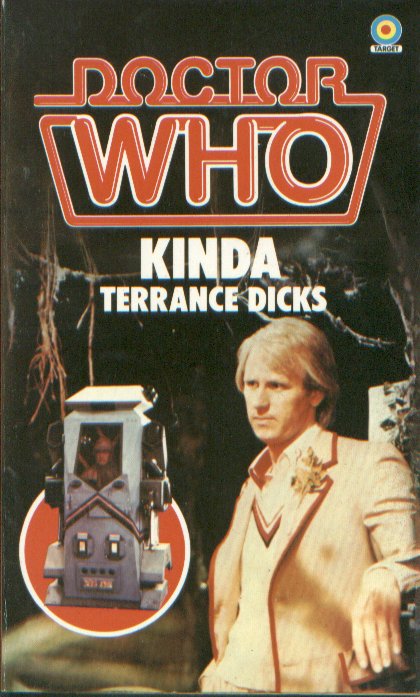Kinda
Doctor Who - Kinda

|
Kinda |
Target novelisation Doctor Who - Kinda |

|
| Author | Terrance Dicks |  |
| Published | 1984 | |
| ISBN | 0 426 19529 9 | |
| First Edition Cover | Photographic |
| Back cover blurb: Nothing could disturb the serene peace of the plant Deva Loka - or could it? An expeditionary force from Earth is dangerously out of control - and it's not only the peaceful race of the Kinda who are at risk... A gentle stroll in the lush jungle leads the Doctor and Adric to an unexpected confrontation - and puts them at the mercy of a maniac... But it is Tegan, lulled to sleep by mysterious wind-chimes, who comes closest to the real danger that threatens not only her sanity but the existence of the whole planet... |
A Review by Jason A. Miller 26/8/11
Kinda is inarguably one of the most complex Doctor Who scripts ever written. The basic story (if you can call it basic) is informed by Christian, Buddhist and Freudian concepts. The first proper words spoken ("What's the matter, boy? Bad dreams?") directly foreshadow the plot, which is set into motion by Tegan's nightmare. The solution to the B plot, a broken mirror,informs to the solution to the A plot, a circle of mirrors ("House, M.D." makes frequent use of this device nowadays). There's a lot going on in Kinda, and as I write this on the eve of the US DVD release, I expect we'll learn even more.
So, for a story this deep, why was the novelization written by Terrance Dicks?
The biggest criticism against Dicks' novelization is the same one we've all read on dozens of message boards over the years: for a TV script brimming with so many ideas, and conceptually so far ahead of most of its brethren, a 128-page book could not possibly be adequate. Slotted in between other Season 19 novelizations that elevated the format - Chris Bidmead's Castrovalva and Eric Saward's The Visitation - the bare patches are pretty evident. And as large stretches of the story involve grown Earthmen playing with paper dolls, you need to explain a lot of the subtext to make this palatable.
The novelization does make the Christian imagery quite explicit; even though Dicks never outwardly comments on the symbolism, the repeated references to snakes tempting women and the prominence of apples in the text make it fairly obvious what's going on. And in case you did miss it, the book's third paragraph is a single sentence: "No doubt about it, Deva Loka was Paradise". Hindle's quote from "Abide With Me" is set aside in quotation marks (making it a deliberate reference rather than an accidental allusion); this may be perhaps the most blatant use of Christian imagery in Doctor Who since the final episode of The Romans.
However, Dicks does nothing to highlight the Buddhist and Freudian elements. You'd think, as Barry Letts' right-hand man for five years, and as the guy who wrote the novelization for Planet of the Spiders, that Dicks would have done a little more to bring out the Buddhism. But the characters from the Mara-inspired dream sequence in Tegan's head, named in the TV closing credits as Dukkha, Annica and Anatta, go unnamed in the novelization. Neither is it explicitly made obvious that the three Earth crewmen (Sanders, Todd, and Hindle) represent the ego, superego and id. Maybe had this been a Virgin Missing Adventure all these dots would have been expressly connected. In the short book aimed at the kids, all this is allowed to go by without comment.
The lack of development of Kinda's subtext is largely forgiveable due to Dicks' usual crisp writing, although there is a momentary lapse when he rather redundantly refers to Commander Sanders as "a grizzled, grey-haired veteran". And it's hard to hide the innate cleverness in the script, so Dicks benefits from that. The goings-on amongst the Kinda and the Earth folk (the A and B plots) are directly parallelled; like the Mara, the TSS transport battle machine is said to be "controlled directly from the brain of the wearer". When Tegan argues with the Mara in her dream sequence, the dialogue flows together without any he said/she said, and for a brief moment it all reads like Tom Stoppard, which means, at least in that scene, Dicks really was getting the point across.
A rare continuity error slips by when Dicks tells us that Tegan first met the Doctor at the beginning of his fifth incarnation, which is perhaps forgiveable as Dicks wasn't formally attached to Doctor Who at the time and he didn't get to novelize Logopolis. However, Dicks does obliquely tie the Earth colonists into the established Earth Empire set forth during the Pertwee years ("Presumably this must be the period when the Empire of Earth was expanding throughout the galaxy"). Also added by Dicks to the story is a hint as to the fate of the missing Earth crewmen: "Presumably the three men missing from the Expedition had encountered the Mara, resisted and been driven to madness and death." A nicely dark aside, not hinted at on TV.
Separated from the TV actors, the small guest cast reads just as well on the printed page as they played on TV. Even in print, Doctor Todd is still one of the great not-companions, bouncing off the Fifth Doctor very effectively and more than making up for the abscence of Nyssa. Unfortunately, the long padding sequence in Part Four when Tegan and Adric blame each other for various plot developments - which screams of an Eric Saward-penned workaround to an under-running script - is included nearly verbatim, when Dicks could easily have excised that extraneous material.
In sum, not Dicks' finest hour, but even the shortest of Dicks efforts written on autopilot are still hard to put down.